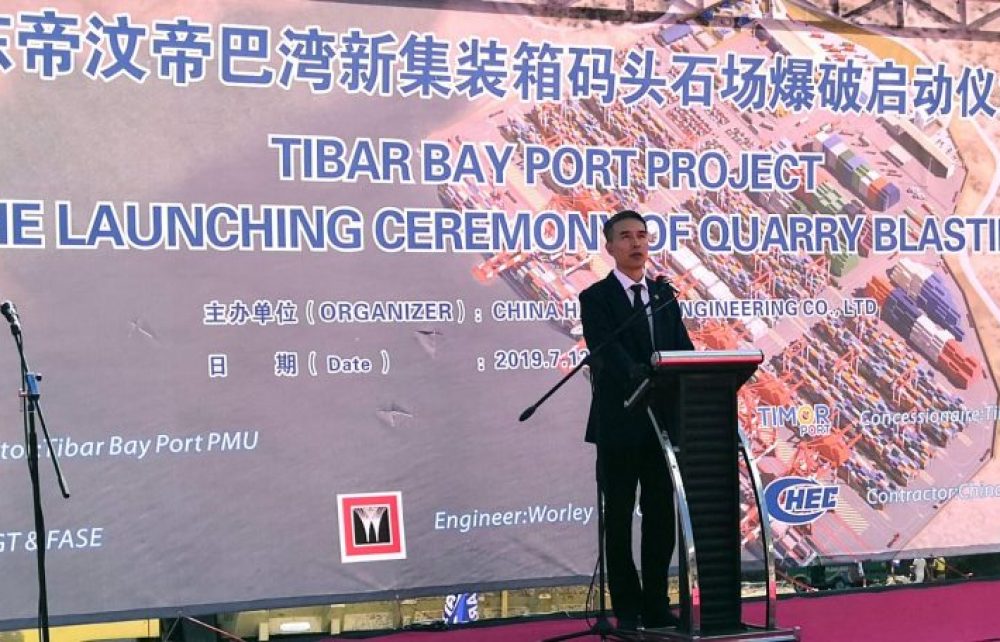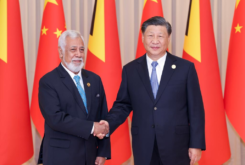Work has begun on building the new deepwater port of Tibar in Timor-Leste. China Harbor Engineering Company (CHEC) is developing the US$490 million project, which will be operated by French firm Bolloré. The scheme is huge in relation to the size of the Timorese economy and the volume of non-oil trade flows, so is it really needed, or will it actually drive economic growth?
After being appointed by the government, the International Finance Corporation (IFC) of the World Bank drew up a list of four international port operators to bid for the contract to build the port: a Portuguese-Belgian consortium, Mota-Engil Ambiente e Serviços, Mota-Engil Engenharia e Construção and Besik Group; the UK’s Peninsular and Oriental Steam Navigation Company (P&O), which is now a subsidiary of DP World; International Container Terminal Services Inc. of the Philippines; and Bolloré Ports.
It was reported that two unnamed Chinese companies were among the interested parties not included on the shortlist because they did not meet the financial or technical criteria. The four interested, pre-qualified parties were invited to submit bids that included the level of subsidy they required. However, P&O and Bolloré were the only companies to actually submit a bid.
Bolloré signed the 30-year concession agreement in June 2016, making it responsible for the design, financing, construction and operation of the facility in line with the government’s masterplan. Under the terms of such concession agreements, which are common in the sector, the port infrastructure itself will remain the property of the state but will be operated by Bolloré.
The French firm’s operations are currently focused on Africa, where 16 out of its 21 port concessions are located, although it also has a concession at the Port of Tuticorin in southern India. When the Tibar Bay concession expires, the government can either launch a tender process for a new concession or appoint a state-owned company to operate the facility.
It is now eight years since the project was unveiled and the government originally wanted it to begin operations in 2016. Work was repeatedly delayed, including in both June 2017 and August 2018, when construction was due to begin but was held up by problems with subcontractors and financing. However, the required financing package was agreed by the end of last year.
About US$280 million will be invested in Phase 1 of the project, with Bolloré contributing US$150 million and the government US$130 million. It was originally expected that Bolloré would invest just US$79 million in Phase 1. The operator plans to invest another US$210 million as demand picks up but it is expected to generate most of this from port revenues.
Container terminal
Tibar Bay is located 10km west of Dili in the district of Bazartete, on the north coast, with rocky headlands at both ends of the bay. The draught of 15 metres will allow access for container vessels with a carrying capacity of up to 7,000 TEU, or twenty-foot equivalent units – the standard measurement of container capacity. The container terminal, which will have two berths on a 630-metre quay, will cover 27 hectares and have storage capacity for 20,000 TEU.
Phase 1 will have a handling capacity of 350,000 TEU a year. By the end of Phase 2, the French firm will have equipped it with 13 rubber-tyred gantry cranes and five ship to shore cranes, giving it the ability to handle 1 million TEU a year. Apart from container capacity, the new port will offer bulk, breakbulk and ro-ro handling. Ro-ro is the term used for vehicle imports and exports, while bulk refers to items such as wheat and cement that are not containerised.
Chinese involvement
CHEC, which is a subsidiary of state-owned contractor China Communications Construction Company, is due to complete construction of Phase 1 by September 2021. Beijing is backing the investment under its Belt and Road Initiative to develop transport infrastructure across the developing world to boost trade between China and other emerging economies.
According to the Chinese ambassador in Timor-Leste, Xiao Jianguo, about 20 Chinese companies are currently working on infrastructure projects in Timor-Leste. Beijing has also helped to finance high profile projects in the country, including the construction of the new presidential palace, the Ministry of National Defence and the Ministry of Finance.
Speaking at the project launch ceremony, the ambassador said: “Chinese-funded enterprises have advanced technology, mature experience and sound management in infrastructure construction such as urban construction, roads and bridges, airports and ports, which have made great contributions to the development of infrastructure.”
He praised the employment and training benefits of the project for local people, adding: “Chinese-funded enterprises are also actively fulfilling their social responsibilities, making up the roads and repairing bridges for local villages and communities, repairing school buildings, etc., and actively integrating into local communities to build harmonious social relations. I hope that Chinese-funded enterprises will continue to develop a hard-working, pragmatic and efficient style, abide by local laws and regulations, and improve environmental protection measures.”
The huge volume of stone needed for the project is being quarried locally after the government decided to wave a ban on all explosions to allow CHEC to source the required stone within the country. The first blasts in July were the first explosions to be sanctioned since independence.
Worley Parsons carried out the front end engineering and design (FEED) study on the project in 2016, followed by project management support from 2018. It was tasked with minimising the negative social and environmental impact of the project, including on people living in the area. The government was also keen to ensure that dredging work did not have too big an impact on coral reefs in the bay. Worley Parsons’ project manager Han Chuan Khor said: “We are striving to make this project the role model for the rest of the construction projects in Timor-Leste.”
Is the port really needed?
The scale of the project raises the question of whether it is the most appropriate choice; although there is no doubt that something had to be done. Timor-Leste’s only existing international port is Dili, which has a draught of just 7 metres and can only handle vessels with a carrying capacity of up to 500 TEU, so it has been clear since before independence that more capacity was needed.
Dili is already unable to keep up with demand and has persistent problems with congestion. It can take ten days to unload a vessel at the port, resulting in demurrage payments – fees paid for unloading delays – to shipping lines, in addition to the tariffs already paid by traders. It can take more than two weeks for a container to be taken out of the port even once it has been unloaded. The port of Dili will close when Tibar Bay opens but it has not yet been announced how the decommissioned site will be used. It could be redeveloped entirely or used as a tourist harbour.
Although Dili’s throughput of just 12,000 TEU a year is insufficient, demand is still a long way short of justifying the construction of a 1 million TEU a year container terminal. Even the government concedes that container demand will take until 2040 to reach 350,000 TEU a year, so Phase 1 will be needed, but it will be a long time before 1 million TEU a year is necessary.
Large ports can sometimes be economically viable in small countries if they position themselves as transhipment facilities, where containers can be offloaded from very big container vessels for distribution to other regional ports via feeder services. Tibar Bay’s 15-metre draft would have been considered deep a decade ago but the biggest container ships can now carry more than 20,000 TEU – three times bigger than Tibar Bay will be able to handle – and so will be unable to access the harbour.
As a result, while transhipment could comprise part of its business, it seems unlikely that it could become the main source of income. However, Philippe Labonne, the chief executive of Bolloré Ports, suggested a transhipment role when he said: “This new ultra-modern portal hub will promote maritime trade, particularly between China and Northern Australia, and thus instil a new economic dynamic in the region”.
The government hopes that developing a large, modern port will encourage the growth of the non-oil economy. Economic diversification is badly needed: the World Bank ranks Timor-Leste as the second most oil and gas-dependent economy in the world after South Sudan, ahead even of Kuwait and Equatorial Guinea.
In a statement, the IFC conceded that the independence war “had left a legacy of poor infrastructure, limited economic development and critically low capacity as the country creates the institutions on which its future will be built”. The project could help to correct that legacy, particularly as the IFC’s involvement brings the support of other World Bank Group organisations, including in developing an adjacent economic zone.
There will be some direct benefits: the project is expected to create 350 permanent jobs and 500 more during construction. In return for its initial investment and some subsidy, the government will receive a proportion of container royalties and some tax revenue. The government also expects the completion of the new port to reduce the cost of doing business in Timor-Leste.
The scheme has benefits in terms of signalling that the country is open for business beyond the oil and gas sector. According to the IFC, the private financing side of the equation is five times bigger than on any other non-hydrocarbon private sector investment in Timor-Leste. In March 2019, the project was voted the best Public-Private Partnership in the Asia-Pacific region at the IJGlobal Awards.
At the project launch ceremony, Prime Minister Taur Matan Ruak said: “with the implementation of the port project, through a public-private partnership…the government gives a signal to other investors that Timor-Leste is an attractive place to do business.”



